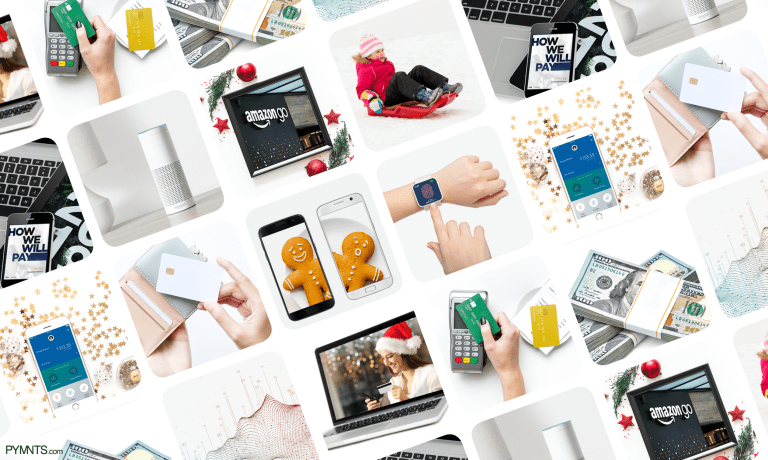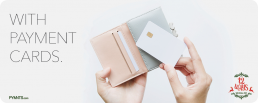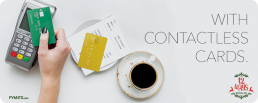12 Ways Consumers Will Pay (And Be Paid) In 2019 And Beyond

The “Twelve Days of Christmas” is a holiday classic, though some of us at PYMNTS still don’t understand why anyone would want to take a partridge away from what seems like a pleasant existence in a pear tree. But in hopes of hopping on the holiday bandwagon — and providing data-backed insight in the hottest payment trends for 2019 — allow us to offer this list of a dozen ways that consumers (and some businesses) are paying now, methods that promise to play big roles in 2019.
For the most part — and unless otherwise noted — this list is built around the new “How Will We Pay” research report from PYMNTS in collaboration with Visa. The findings in the report, which is free for download, comes from the survey responses of 2,800 U.S. consumers who were asked about the devices they own and how they use them to buy things. Those consumers also gave details about the purchases they made in the past seven days, the devices they used to make those purchases and why they made a purchase with that device in that way.
The findings — reflected in the list below — take into account the newest payment technologies while also paying attention to legacy methods that for various reasons continue to command consumer and business loyalties.
So, how will consumers (and some businesses) pay?
#1: With Multiple Devices

Owning just a smartphone — which applies to 3 percent of the population — seems so ancient these days that it’s not even hip or retro (give it time, though). Merchants must appeal to consumers who shop and transact via various web-connected gear. That not only includes smartphones, tablets and other computers — 17 percent of consumers own those but no other such devices — but connected appliances and speakers (35 percent of consumers, with the smart speaker market experiencing significant growth), and wearables (whose users, on average, have annual incomes of $79,406). More generally, 36 percent of consumer own six or more devices, and you can bet that percentage will grow in the near term.
#2: With Their Voices

Voice-assisted retail is growing faster than many observers expected, and some 27 percent of consumers own a voice-activated device, up from 14 percent last year. Consumers are being well trained to use voice for web searches and other activities, and are buying voice-activated devices that can perform payment and commerce tasks. The lucrative “Bridge Millennial” consumer segment — relatively high earning and highly educated, and approaching their peak earning years — are particularly fond of this technology, with 31 percent of owning a voice-activated speaker. Moreover, Adobe projects that voice-assisted retail will prove to be a big hit during the 2018 holiday shopping season — and that consumers already devoted to the technology will buy even more gear for themselves and others.
#3: Via Automatic Payments

No one likes checkout friction, and the growth of automatic payments enables consumers to have seamless transactions and go on with their lives. In 2018, 49 percent of surveyed consumers expressed interest in making automatic payments at the gas station, up from 41 percent in 2017. That’s not all. Interest in making automatic payments at restaurants, rather than waiting for the check, increased from 37 percent to 39 percent.
#4: Via Quicker Payouts

It’s not just consumers who pay, of course, but business and other organizations. And no one likes to wait around for funds, whether they come via paychecks or disbursements. The ongoing deployment of real-time payment technology is helping to meet such demands while bringing payment infrastructure further in the digital age. Some 24 percent of consumers would like to be paid in real time, and a hefty 70 percent of consumers are interested in shorter pay cycles. Quicker payments can have wide impact: Consumers said that if they were paid faster, they would be able to better manage their cash flow (53 percent) and pay bills (53 percent).
#5: With Payment Cards

Don’t even think of counting out plastic, which still carries a wide appeal. The propensity to use credit and debit cards on connected devices is particularly high among Baby Boomers and Bridge Millennials — with 72 percent and 53 percent using these channels, respectively. Credit and debit cards are also the preferred method of paying when consumers travel abroad. Among the 54 percent of participants who had made a purchase from foreign merchants, 68 percent preferred using credit and debit cards while purchasing from them.
#6: With Person-To-Person Mobile Tech

It’s been a year of P2P payment gains, and all signs point to even more growth in 2019. Zelle — the P2P service backed by Bank of America, JPMorgan Chase and other financial institutions (FIs) — said in its Q3 results that transaction volume increased 16 percent year over year, and that the total amount of money moved increased 13 percent during that same time frame. In PayPal’s recent Q3 financials, Venmo played a significant part in the positive nature of that report, with Venmo’s total payment volume increasing by 78 percent year over year. Such growth has led to payment services providers making sure in incorporate P2P in their offerings, including for restaurants.
#7: With Biometrics

The promise of biometric payments — closely tied to biometric authentication and ID verification — was demonstrated recently in China on Nov. 11, otherwise known as Singles’ Day, a big online shopping event in that country. According to one report, some 60 percent of customers paid by fingerprint or by taking a selfie during Singles’ Day. India-based Paytm, meanwhile, has started working on a facial recognition tool to enable digital payments.
#8: Via PayPal

The 2018 holiday shopping season has been more than kind so far to PayPal. For the first time in the company’s history, mobile payment volume topped $1 billion, and did so on both Black Friday (Nov. 23) and Cyber Monday (Nov. 26). On Black Friday specifically, mobile payment volumes exceeded that of Cyber Monday, though Cyber Monday still had a higher total payment volume. Black Friday mobile payment volume increased 42 percent year over year. And that’s not all. Braintree, acquired five years ago by PayPal, recently announced that it had processed more than $500 billion worth of transactions since then. It was only three years ago that Braintree achieved $50 billion in payments volume.
#9: With a Sense of Enjoyment

Let’s be honest: Until recently, payment was mundane, not fun. No one likes handing over hard-earned money to other people, not really, no matter the purchase. But that’s changing in this era of mobile and digital commerce. That’s because connected devices can make purchasing experiences more enjoyable for the consumer — assuming the user interface is not counter-intuitive and designers and merchants put serious thought into the customer experience. There was an increase of more than 13 percent in the number of consumers who told PYMNTS that they used connected devices to pay for things because they enjoyed them, growing from 47 percent last year to 60 percent.
#10: With Contactless Cards

It’s alright to be skeptical about contactless card adoption in the U.S., given the years of promise that regularly fell short of reality. But this year brought proclamations from Visa and others that U.S. consumers are finally ready to take up contactless transactions. Lower costs of card issuance, increasing consumer demand and speed are among the factors behind that. In fact, PYMNTS found that 26 percent of consumers expressed interest in using contactless cards at physical stores. Of those consumers, 84 percent see grocery as the predominant use case.
#11: Without Cash

Make no mistake: People are indeed moving away from coins and bills, and doing so rapidly. A big part of the reason is the increase in digital and web connections — 36 percent of consumers own six or more connected devices, which is hardly an optimistic data point for cash, not when there are so many other relatively easy and seamless ways to pay via mobile and the web. Those connections also mean that merchants and payment services providers keep working harder to meet consumer demand for digital payments (and, more often, not just payments, but also payment experiences, something cash cannot offer). Indeed, consumers are eager to move away from cash, with 77 percent of them wanting to use contactless payments at gas stations. Digital payments continue to make inroads everywhere. More than half of consumers used connected devices to make a purchase in seven of the 13 categories queried: 28 percent said they bought clothing and accessories, and 20 percent said they bought groceries. Sure, consumers do carry cash: Half of them carry between $10 and $15 in their wallets. But that cash is largely reserved for tipping — 39 percent of consumers said that — and purchases from smaller merchants that do not accept cards. But with the increasing deployment of relatively low-cost, low-hassle point-of-sale systems for even the tiniest of merchants, that doesn’t seem to promise a bright future for cash, either.
#12: With Growing Caution

No one has to tell PYMNYTS readers that consumers — and lawmakers and regulators and the media — are paying a lot more attention to online security and privacy, and that it’s almost certain that 2019 will bring more efforts to craft more laws to address those problems. When it comes to how people pay, 79 percent of consumers expressed concerns over data security when using connected devices to enable payment, an increase of 11 percentage points. Almost as many, 78 percent, expressed concerns over the privacy of their data. That means merchants, financial institutions and payment services providers who can address those concerns while also offering relatively friction-free transactions will gain an edge.
The coming year will bring new entrants to this list — new trends and experiments. But these dozen ways to pay provide a strong look at what’s in store for 2019.